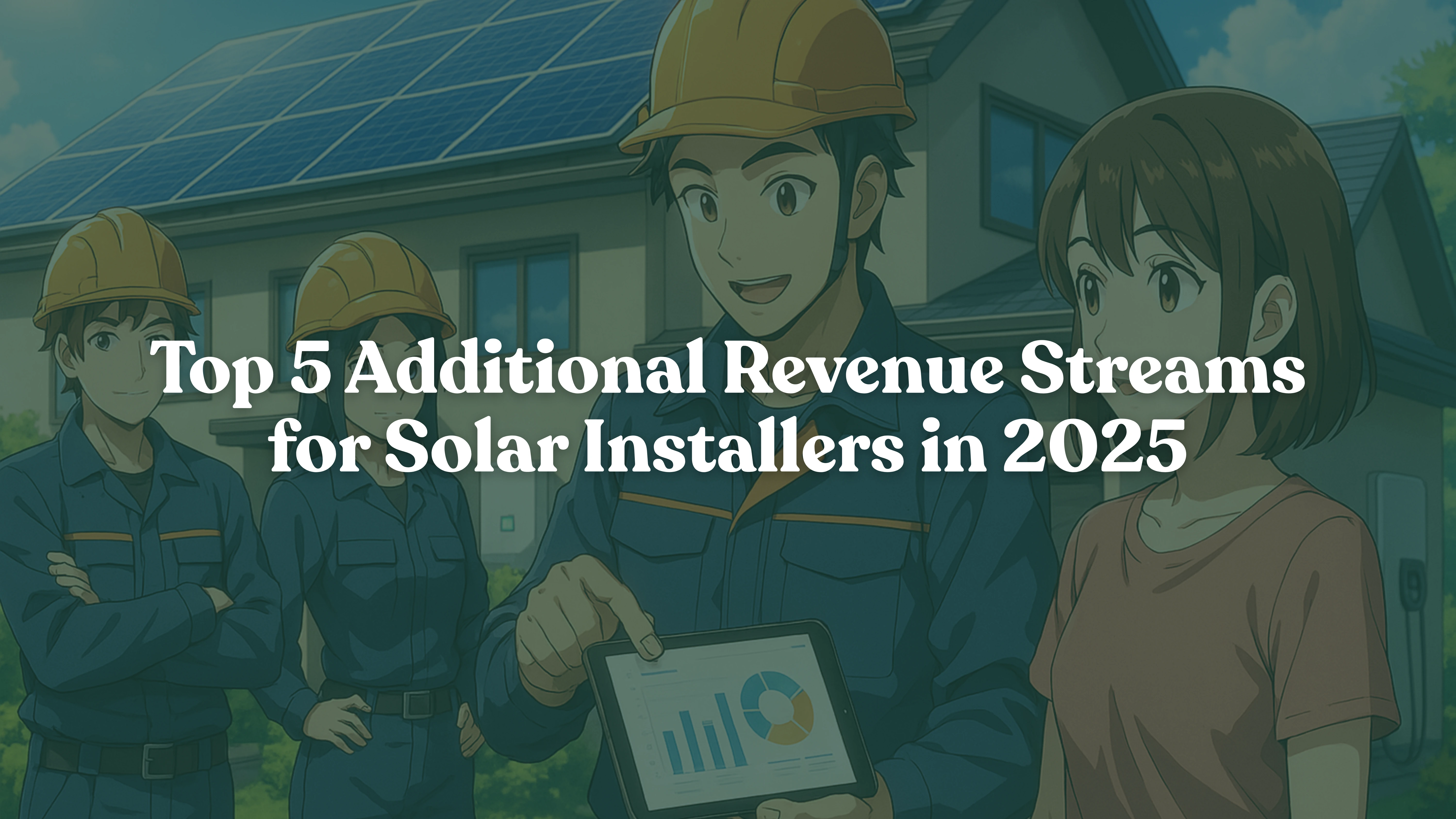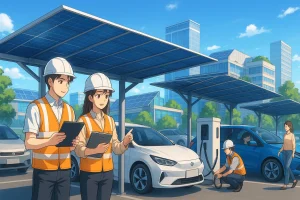5 Alternative Revenue Streams Every Solar Installer Should Add in 2025

The Solar Installation Crisis: Why Diversifying Revenue Matters Now
The solar industry is experiencing a significant shift. Over 100 residential solar companies closed in 2023, with more following in 2024. Solar installers face mounting pressure from reduced incentives, high interest rates, and intense competition. However, successful contractors aren’t just surviving—they’re thriving by diversifying their solar revenue streams beyond traditional panel installations. These five proven strategies can transform your installation business from a one-time transaction model into a multi-service powerhouse that delivers predictable profits and strengthens customer relationships.
Why Solar Installers Need Revenue Diversification Now
The residential solar market saw a 29% year-over-year decline in early 2024. Consequently, installers must rethink their business models. Moreover, contractors who implement multiple solar revenue streams report 20-40% higher profit margins. In contrast, those relying solely on new installations struggle to maintain profitability. The installed solar capacity in the United States has surpassed five million systems. As a result, this creates massive opportunities for service-based income that successful EPCs are already capturing.
1. Battery Energy Storage: The Fastest-Growing Alternative Revenue Stream
Battery attachment rates jumped from 18% in Q2 2023 to 70% in Q2 2025. Therefore, energy storage has become the hottest opportunity for expanding your solar revenue streams. Furthermore, the global solar battery market is projected to grow from $297.13 million in 2025 to $1,001.31 million by 2033. This represents a compound annual growth rate of 16.4%.

Why Battery Storage Works for Your Business:
Residential electricity prices are expected to average 16.7 cents per kWh in 2025. This marks an increase from 15 cents in 2022. Consequently, homeowner demand for backup power and bill management continues rising. Additionally, installers offering battery systems deliver more than storage—they provide energy independence and long-term savings. Battery installations also create opportunities for Virtual Power Plant (VPP) programs. In these programs, aggregated home batteries dispatch power during peak demand. As a result, this generates additional income for both installers and homeowners.
Smart contractors bundle battery storage with new solar installations. Meanwhile, they retrofit existing systems, creating two distinct revenue opportunities. Importantly, energy storage remains eligible for tax credits through 2032 under lease agreements. This makes it financially attractive for customers while boosting your project values.
2. EV Charging Infrastructure: Capture the Transportation Electrification Wave
The solar-powered EV charging station market reached $26.31 billion in 2025. Moreover, it’s growing at 14.91% CAGR to reach $52.85 billion by 2030. Commercial properties installing solar frequently want EV charging stations. Therefore, this creates a natural upsell opportunity. This income stream taps into the accelerating shift toward electric vehicles without requiring a complete business pivot.

Revenue Opportunities in Solar EV Charging:
Installers can offer Level 2 workplace chargers, DC fast charging for commercial fleets, and integrated solar canopy installations. Furthermore, the federal Investment Tax Credit offers a 30% tax credit up to $1,000 for residential installations. Many states provide additional rebates. For instance, California provides up to $2,000 for EV charger installations. Similarly, New York and Massachusetts offer comparable programs.
For EPCs, pairing EV charging with solar and battery storage creates comprehensive energy solutions. In fact, the US VPP market hit 37.5 GW in 2025. EVs and batteries are driving this growth, showing how interconnected these technologies have become. As a result, contractors who position themselves as complete energy solution providers win bigger contracts and build lasting client relationships.
3. Operations & Maintenance Services: Build Recurring Income
The global solar panel operation and maintenance market reached $15.73 billion in 2025. Furthermore, it’s forecasted to hit $32.63 billion by 2034, expanding at an 8.44% CAGR. Developing strong O&M capabilities should be a priority for anyone looking to diversify their solar revenue streams with predictable, recurring income.
Why O&M Creates Sustainable Income:
Over 100 residential solar companies closed in 2023. Consequently, they left behind incomplete or orphaned systems that need service. These orphaned installations create immediate opportunities for contractors offering O&M services. Additionally, homeowners with existing systems always require troubleshooting, inverter replacements, and performance checks. Therefore, this makes O&M a reliable income source.
According to McKinsey, thorough O&M services increase business owners’ ROI by 10% to 30%. This improvement comes through maximized energy generation, decreased repair costs, and increased system lifetime. Installers can offer tiered service packages—from basic annual inspections to comprehensive performance guarantees. As a result, this creates multiple price points that appeal to different customer segments.
Modern O&M leverages AI-powered monitoring platforms. These platforms track performance at the string or panel level. Consequently, contractors can identify issues before they become costly failures. Well-maintained installations can maintain 95% of their original capacity after 20 years. In contrast, poorly maintained systems may drop to 85% or lower. That 10% difference translates to significant revenue for utility-scale projects.
4. Energy Efficiency Audits and Retrofits: Maximize Every Installation
The IRS now offers a $150 tax credit for home energy audits beginning in 2024. Therefore, this makes energy efficiency services more attractive to customers. Most homeowners see a 20-30% reduction in monthly energy bills after implementing audit recommendations. This translates to thousands in annual savings.

How Energy Audits Boost Your Business:
Energy efficiency audits help installers right-size systems. As a result, they prevent costly oversizing while ensuring adequate power generation. This optimization typically results in 15-25% lower installation costs compared to non-audited projects. Moreover, when you conduct pre-installation audits, you can bundle LED upgrades, insulation improvements, and smart thermostats. Consequently, this increases project values and customer satisfaction while diversifying your service offerings.
Energy audits can tailor recommendations to economic criteria. Specifically, they limit measures to those with paybacks of 2 to 5 years. Lighting retrofits and electric water heater upgrades often fall under this threshold. Furthermore, by decreasing a building’s energy use before installation, you maximize the value from the customer’s investment. Meanwhile, you potentially reduce the required system size—creating win-win scenarios.
5. Commercial Solar and Third-Party Ownership Models
Commercial Section 48E credit remains available through 2027. Additionally, projects beginning construction by July 4, 2026, qualify for the full 30% credit. Commercial installations provide new solar revenue streams through larger project sizes. Moreover, power purchase agreements and lease arrangements create long-term relationships with business clients.
Why Commercial Projects Diversify Your Income:
Commercial projects typically range from 100kW to several megawatts. Consequently, they deliver higher revenues per installation than residential work. Third-party ownership (TPO) models allow installers to maintain ownership of systems. As a result, they earn predictable income through power purchase agreements. Meanwhile, customers enjoy reduced electricity costs without upfront investments.
EPCs that successfully transition to commercial work often find more stable cash flows. Furthermore, they experience less exposure to residential market volatility. Successful businesses focused on their strengths while diversifying income streams. Specifically, they added re-roofing, battery upgrades, and retrofits. This demonstrates how multiple services create resilience.
Take Action on Your Business Growth Today
The installation companies thriving in 2025 aren’t waiting for market conditions to improve. Instead, they’re actively building diversified solar revenue streams that complement their core work. Start by evaluating which services align with your capabilities, market demand, and team strengths.
At Energyscape Renewables, we help contractors expand into battery storage, streamline operations, and capture new income opportunities. Pair your strategy with Sunscape’s tools to automate proposals and manage multiple services seamlessly. The installers building the strongest businesses aren’t chasing volume—they’re building value through diversification.



sjayakanth@energyscaperenewables.com